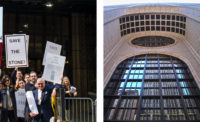A former business partner of acclaimed architect Philip Johnson (1906—2005) recently unveiled an archive of nearly 25,000 sketches, tracings, and renderings from between 1968 and 1992, a sparsely documented period of Johnson’s prolific career.

Raj Ahuja, AIA, the archive’s owner, has put the collection up for sale after holding on to it for nearly two decades. While he hopes to keep the archive intact, he sold a 7 1⁄2-foot hand drawing of the AT&T Building to London’s Victoria & Albert Museum in April for $70,000.
How Ahuja came to own the archive is an interesting story. In 1971, the Indian-born architect joined Johnson Burgee Architects — headed by Johnson and John Burgee — and ran the firm’s Iranian office. In 1984, Ahuja became a firm partner. Problems ensued. Johnson stepped down as partner in 1986 and became a design consultant; in 1991, he left the firm altogether.
Ahuja and Burgee also parted ways — and not amicably. Burgee decided to terminate their partnership in 1988, and the two went into arbitration.
In early 1992, the arbitration panel awarded Ahuja $13.6 million, minus $1 million previously paid by Burgee as an initial settlement. Shortly afterward, Burgee filed for bankruptcy and Ahuja became a creditor. He accepted the archival material as part of his compensation.
Lawyers Andrew Ross and James Frankel of Arent Fox, who represent Ahuja, report that the meticulously preserved collection includes a wealth of unrealized projects, along with urban plans (an area of design for which Johnson was not known). Among these drawings are a master plan for New York City’s Roosevelt Island and a turreted design for the city’s Trump Tower. The archive also includes architectural photography by Ezra Stoller and Richard Payne.
However, according to John Burgee, now living in California, the archive is composed mainly of working drawings, design-development drawings, and renderings, not necessarily hand sketches by either Johnson or Burgee. “We did not keep our sketches — Philip and I did not feel they were that good. The sketches were only quick dashes, and Philip wanted them destroyed,” says Burgee. “Most were not dated or signed.”
Presentation drawings, such as the one executed for the AT&T project, Burgee notes, were not done by the principals, but by draftsmen. “I was so surprised to hear about the value of the one sold to the Victoria & Albert Museum,” he says.
The existence of this extensive archive comes as a surprise. While New York’s Museum of Modern Art (MoMA), Columbia University’s Avery Architectural and Fine Arts Library, and the Getty Research Institute each have Johnson archives, documentation from the later period of Johnson’s career is rare.
Ahuja’s collection is currently being stored in a New Jersey vault. As for potential buyers, Ross says, “I can confirm we’ve had calls of interest,” but declined further comment.
Editor’s Note: This story originally ran on July 28, 2010, and was updated on August 23, 2010.




